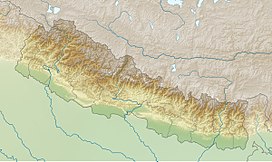Pumori
| Pumori | |
|---|---|

View of Pumori from Everest Base Camp, Khumbu Valley
|
|
| Highest point | |
| Elevation | 7,161 m (23,494 ft) |
| Prominence | 1,278 m (4,193 ft) |
| Coordinates | 28°00′53″N 86°49′41″E / 28.01472°N 86.82806°ECoordinates: 28°00′53″N 86°49′41″E / 28.01472°N 86.82806°E |
| Geography | |
| Location | Nepal-Tibet |
| Parent range | Himalayas |
| Climbing | |
| First ascent | 1962 by Gerhard Lenser |
| Easiest route | snow/ice climb |
Pumori (Nepali: पुमोरि) (or Pumo Ri) is a mountain on the Nepal-Tibet border in the Mahalangur section of the Himalayas. Pumori lies just eight kilometres west of Mount Everest. Pumori, meaning "the Mountain Daughter" in Sherpa language, was named by George Mallory. "Pumo" means young girl or daughter and "Ri" means mountain in Sherpa language. Climbers sometimes refer to Pumori as "Everest's Daughter". Mallory also called it Clare Peak, after his own daughter.
Pumori is a popular climbing peak and the easiest route is graded class 3, although with significant avalanche danger. Pumori was first climbed on May 17, 1962 by Gerhard Lenser on a German-Swiss expedition. Two Czechs (Leopold Sulovský and Zdeněk Michalec) climbed a new route on the south face in the spring of 1996.
An outlier of Pumori is Kala Patthar (5,643m/18,513'), which appears as a big brown bump below the impressive south face of Pumori. Many trekkers going to see Mount Everest up close will attempt to climb to the top of Kala Patthar.
Nearly 500 people had summitted Pumori by 2005, at a cost of 42 lives. It was noted for its increasing popularity by 2008, with such features as being able to use the Everest base camp for Nepal (when its occupied that is) when trekking or climbing Pumori and offering solid views of Tibet, Nepal and Everest. However, there has been some dangers from avalanches including some Spanish climbing teams that took heavy losses (such as in 1989 and 2001), and the 2015 avalanche, though it was likely triggered by the 2015 Earthquake, is said to have originated from the Pumori-Lingtren ridge.
...
Wikipedia

